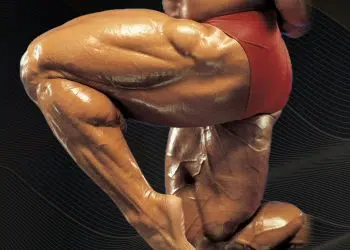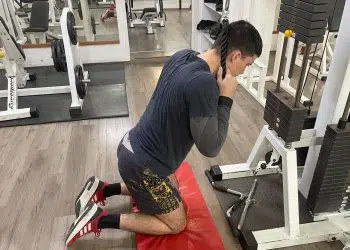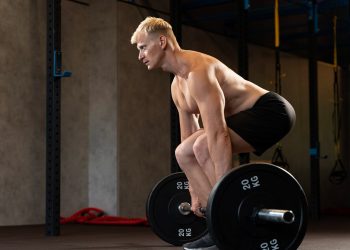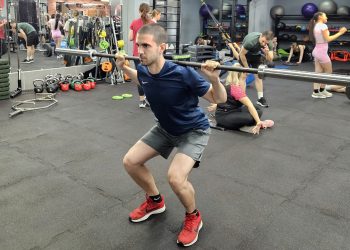The cable pull-through (with rope) is a very effective exercise for the hamstrings and glutes that are located on the lower posterior chain, in addition to developing proper hip movement. These muscles are important for physical or athletic performance and for filing out those jeans too!
This is a simple exercise and anyone can do it effectively with proper form. But the great thing about using cables is that they keep constant tension on the muscle and this is a necessary component of muscle hypertrophy.
The cable pull-through is a great addition to any workout routine, and it’s ideal for lifters of all levels of experience levels. So, try it out and see how it improves your leg development!
Here’s a guide to the cable pull through…
Muscles Worked
The cable pull through (with rope) engages many muscles of the lower body. Here are the main muscles involved.
Glutes
The glutes or butt muscles consist of the gluteus maximus, gluteus medius, and gluteus minimus. The gluteus maximus is responsible for most of the butt’s shape, and function and its primary function is to extend and externally rotate the thigh. It can also act as an extensor when force is necessary (e.g. from sitting to standing).
Level Up Your Fitness: Join our 💪 strong community in Fitness Volt Newsletter. Get daily inspiration, expert-backed workouts, nutrition tips, the latest in strength sports, and the support you need to reach your goals. Subscribe for free!
Hamstrings
The hamstrings are located opposite the thighs, on the back of the upper leg, and are composed of three muscles: semitendinosus, semimembranosus, and biceps femoris. The primary function of the hamstrings is hip extension and knee flexion. The hamstrings are highly involved in explosive lower body movements such as sprinting and jumping.
During butt kicks, the hamstrings generate extension force at the hip and resist knee extension.
Erector spinae
The erector spinae muscles include the intermediate layer of the deep back muscles. It’s composed of the spinalis, longissimus, and Iliocostalis muscles.
The erector spinae functions to move the vertebral column. The bilateral contraction of the erector spinae extends the spine, while unilateral contraction causes lateral flexion (ipsilateral). These muscles are also important for maintaining posture.
Iliopsoas
The iliopsoas is the primary hip flexor. It’s composed of the major and minor psoas muscles and the iliacus muscle, that form the iliopsoas musculotendinous unit (IPMU). The muscles can function separately to stabilize the pelvis and lumbar spine during hip movement, and support flexion of the trunk.
How To Do The Cable Pull Through
Here are step-by-step instructions for the cable pull through (with rope).
- Set up a double rope attachment to a low cable pulley about knee height.
- Then, face away from the cable machine and grab the rope attachment with both hands between your legs.
- Stand up and take a few steps away from the machine, plant your feet firmly, and keep your arms straight. Your shoulders should be down and back with a good posture.
- With knees slightly bent, core tight, and posterior engaged, hinge forward at the hips until your torso is parallel to the floor. Your back should remain straight while the shins stay vertical or perpendicular to the ground. You should feel a good stretch in your hamstrings and the weight should feel evenly distributed through your feet.
- Engage your glutes, then drive your hips forward and up until you’re in a standing position but don’t hyperextend your lower back. Keep your glutes tight and flexed.
- Repeat for the desired number of reps.
Here’s a video example…
Cable Pull Through Tips:
- Drive your hips forward with your heels during the concentric (positive) portion of the exercise.
- Pull with your glutes and hamstrings and avoid using your back.
- Do not hyperextend your lower back upon standing. You want to end in a straight line with the glutes flexed.
- Start with light to moderate weight and increase as you become more proficient with the exercise.
3 Variations/Alternatives
Here are three variations of the pull through.
Resistance band pull through
The resistance band pull through is great because you don’t need a cable machine to do it. If you have resistance bands and a stable object to attach it to, you can do this exercise. Note that the further you stand from the anchor where the band is attached, the more challenging the exercise will be.
Level Up Your Fitness: Join our 💪 strong community in Fitness Volt Newsletter. Get daily inspiration, expert-backed workouts, nutrition tips, the latest in strength sports, and the support you need to reach your goals. Subscribe for free!
You also want to make sure that there’s always tension in the band so you’ll need to stand far enough away from the anchor to ensure this. We recommend starting with a light resistance band if you’re new to the exercise, and after a few sessions, you can increase the resistance or stand further away from the anchor if possible. It’s a good idea to mark the area where your feet are during the resistance band pull through if you plan to increase the difficulty of the exercise by moving further away from the object that it’s attached to.
See it in action below…
Kettlebell swing
The kettlebell swing is one of the most incredible exercises in existence. It’s literally a proven movement that develops your posterior chain and core, improves explosiveness and hip activity which is crucial for maximizing athleticism, and it increases functional strength.
Because it involves a quick snap forward, the hamstrings are benefiting greatly which will carry over to your athletic performance.
Related: 12 Must-Do Kettlebell Exercises For Hypertrophy, Strength and Function
Barbell hip thrust
More of an alternative exercise, believe us when we say that the barbell hip thrust is the best glute builder there is. You can really load this exercise heavy to maximize strength and hypertrophy, not to mention, research has shown the hip thrust to be a superior exercise as the weight has to be overcome from the hips as the bar sits right at the crease.
Also read: The Best Hip Extension Exercises
How To Incorporate The Cable Pull Through (With Rope) Into Your Training Routine
We recommend doing the cable pull through after you’ve completed your primary multi-joint, compound lifts (e.g. squats, deadlifts, leg press). That’s because you need all of your strength and power for the aforementioned movements, and this is more of an accessory exercise that you can use to really focus on the stretch and contraction of the lower posterior muscles.
However, the cable pull through may also be used to pre-exhaust the glutes and hamstrings before your bigger lifts.
Sets/Reps
As with most common exercises, we recommended 3-4 sets of anywhere from 5-20 reps, varying the reps within this range.
If you want to develop more strength, then training in the lower rep ranges of 5-reps. For hypertrophy, 8-12 reps is ideal, and for endurance/conditioning, we recommend 15-20 reps. But it’s a good idea to mix up your rep ranges every now and then to get the best of all rep ranges.
Reps/sets also depend on how your training routine is scheduled. If you go in and do max deadlifts, then you’ll probably want to go lighter and do higher reps. But if you’re training higher reps on your big movements, then it could benefit you to add some heavier sets of cable pull-throughs.
Wrapping Up
The cable pull through (with rope) is an exercise that we recommend because it’s not very taxing on the body and it works the lower posterior chain muscles quite nicely. Just make sure to use proper form and gradually increase the resistance to benefit most from this movement. And also be sure to include some of the variations and alternatives to maximize your glute and hamstring development.
Interested in measuring your progress? Check out our strength standards for Deadlift, Hip Extension, Hip Thrust, and more.











